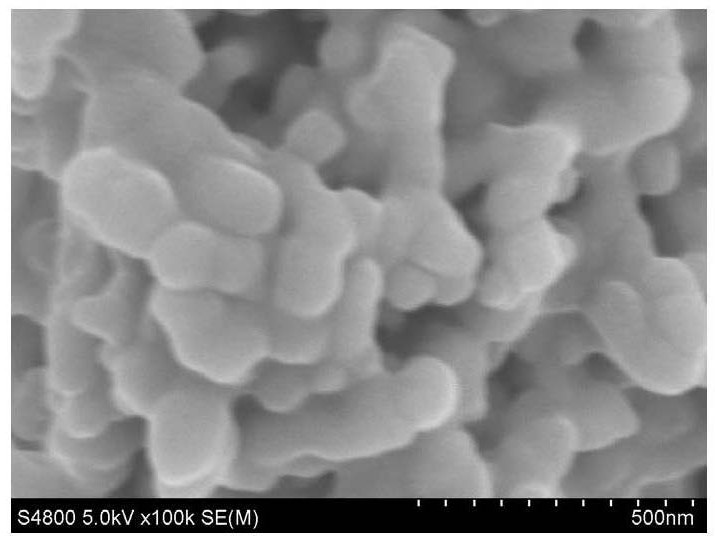Efficient vanadium nitride/molybdenum carbide heterojunction hydrogen production electrocatalyst and preparation method and application thereof
An electrocatalyst and heterojunction technology, which is applied in the direction of electrodes, electrolytic components, electrolytic processes, etc., can solve the problems of affecting the electron transmission rate of electrodes, difficult to control the morphology, and poor conductivity, so as to promote synergistic catalytic effect and easy control , good stability
- Summary
- Abstract
- Description
- Claims
- Application Information
AI Technical Summary
Problems solved by technology
Method used
Image
Examples
preparation example Construction
[0040] Figure 5 It is the nanometer VN / Mo that embodiment 3 prepares 2 The hydrogen production performance graph of C at pH 14, when the current density is 10mA / cm 2 , when the scan rate is 3mV / s, the overpotential of the sample is 95mV, indicating that it has excellent hydrogen production performance.
[0041] Example 4
1) Weigh melamine, ammonium metavanadate and ammonium molybdate tetrahydrate according to the mass ratio of 20:3:1.
2) Dry mix the above powders and grind them in an agate mortar for 20 minutes, put them into a porcelain boat, place the porcelain boat in a tube-type atmosphere furnace, and put two furnace plugs at each end of the tube with an interval of 5cm.
3) Introduce argon gas into the tube, and then carry out 6 times of pumping and replenishing air, even though the air inside is exhausted, and do not pump after the last gas replenishment. Pass in an inert protective atmosphere (argon) at a flow rate of 40 sccm, raise the temperature to 400°C at 5...
Embodiment 1
[0049] Comparative example 3
[0050] When the composite material is prepared with thiocyanic acid: ammonium metavanadate: ammonium molybdate tetrahydrate according to the mass ratio of 19:5:3, the XRD of the sample is as follows Figure 14 As shown, it can be seen that VN and Mo 2 The diffraction peak of C matches well with the standard card, but the intensity of the diffraction peak of VN is very weak, indicating that the nitrogen content of carbon and nitrogen homologous compounds is below 30%, which is not conducive to the formation of VN. Figure 15 is the TEM image of the sample, VN and Mo can be seen in different parts of the sample 2 C lattice stripes, no heterojunction structure was found. Combined with XRD and TEM analysis, it can be seen that when the nitrogen content of carbon and nitrogen homologous compounds is below 30%, the formation of VN is affected, and VN and Mo are also not formed. 2 The heterojunction structure of C affects the catalytic performance of...
Embodiment 2
PUM
 Login to View More
Login to View More Abstract
Description
Claims
Application Information
 Login to View More
Login to View More - R&D
- Intellectual Property
- Life Sciences
- Materials
- Tech Scout
- Unparalleled Data Quality
- Higher Quality Content
- 60% Fewer Hallucinations
Browse by: Latest US Patents, China's latest patents, Technical Efficacy Thesaurus, Application Domain, Technology Topic, Popular Technical Reports.
© 2025 PatSnap. All rights reserved.Legal|Privacy policy|Modern Slavery Act Transparency Statement|Sitemap|About US| Contact US: help@patsnap.com



